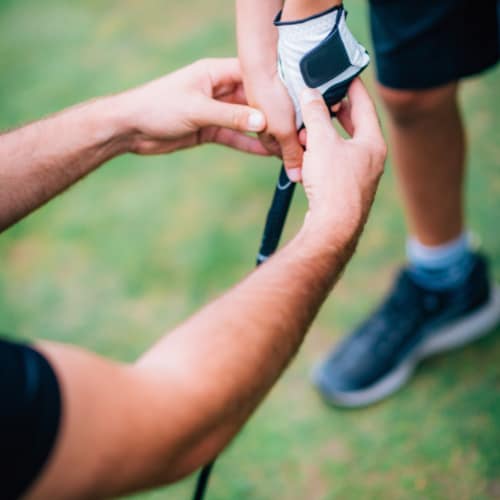Do you struggle with consistency in your golf game? One day you’re hitting great shots, and the next day you can’t seem to get it right. It’s frustrating and can make the game less enjoyable.
A consistent golf swing is the holy grail of every golfer. It is the key to hitting the ball straight and far, and ultimately, to lowering your score. However, consistency in golf is easier said than done.
In this article, I’ll share 15 tips for a more consistent golf swing. From proper grip and stance to swing tempo and follow-through, these tips will help you achieve a more consistent, reliable swing that leads to better shots and get your performance back.
What is Consistency in Golf?

Consistency in golf is the ability to make solid contact with the ball and produce a desirable ball flight repeatedly. It means hitting consistent shots, minimizing mistakes, and playing with a solid game plan. Establishing consistency is important because it leads to solid scoring and makes it easier for you to achieve your desired outcome.
To achieve a consistent golf game, you need to minimize mistakes by making the right choices. For instance, if a golf shot requires a high risk for a low reward, it is better to choose a safer shot that would lead to better odds of success. This way, you would be making controlled choices that reduce unwarranted risks and mistakes.
Sticking to a game plan is also important for consistency in golf. With a clear plan in mind, you’re less likely to alter your swing during shots, which may cause inconsistency and result in bad rounds. A good game plan considers your strengths as a player and complements the course to help you make consistent shots.
Converting around the greens is another important factor for consistency. The most consistent players have a successful short game. Converting shots around the greens helps to gain shots by making up for the bad shots you might have made earlier in the game.
How Do I Improve My Consistency In Golf?
Improving consistency in your golf swing is a crucial aspect of becoming a successful golfer. Whether you’re a beginner or a seasoned player, achieving a consistent swing can help you hit better shots, avoid bad habits and improve your overall game. Here are some tips on how to improve your consistency in golf.
1. Start By Assessing your stats

Before you start working on your swing or investing in new clubs, it’s important to identify which areas of your game need improvement. One effective way to do this is by assessing your golf stats.
Start by tracking how many fairways you hit, the direction in which you miss shots, the number of greens hit from 110 yards (around 100 meters) in, the proximity of your chips to the hole, and putts per round. You can use golf apps like GolfShot, 18Birdies, or The Grint to easily track your stats, or write them down in a notepad or on your phone.
Alternatively, you may want to take advantage of the latest technologies and invest in a quality launch monitor to get readings of your shots and record videos, and keep statistics of your game.
Through analyzing your stats, you can determine the areas in which you need to focus your practice and work towards improvement.
So take the time to analyze your performance and tailor your practice accordingly. Your improvements might surprise you.
2. Develop a Strong Game Plan

Developing a strong game plan is essential for consistent and successful play. A solid strategy can help you approach each hole with purpose and confidence, ultimately leading to better performance on the course.
To create your own game plan, start by assessing your current strengths and weaknesses in your game. This will allow you to customize your approach and take advantage of your skills while minimizing potential mistakes.
Consider the layout of the course and identify potential hazards or challenges that you may face. This can help you decide which clubs to use and where to aim your shots. For example, if there is a water hazard on the left side of the fairway, it may be wise to choose a club that allows you to lay up short and avoid the hazard altogether.
Remember to play your own game and not try to replicate the style of other golfers. Everyone has their own strengths and weaknesses, and it’s important to play to your own strengths to achieve consistent success on the course.
Developing a strong game plan takes time and practice. With persistence and patience, you will see improvements in your game and confidence on the course.
3. Focus on the basics

To improve your consistency in golf, focus on the fundamentals of the game. Setting up the golf ball correctly, aiming, and having a proper grip, posture, swing, and balance are all crucial aspects of a consistent golf swing. Practicing these basics at home (using a golf simulator) can improve muscle memory and set you up for success on the course.
Establishing a strong pre-shot routine is also crucial for consistent shots. This routine may include an alignment component, a practice swing, and a mental thought, repeated for every shot. This routine will help you get into the right mindset before every shot and ensure that your body is properly aligned for greater consistency.
Simplifying your swing can also lead to a better consistency. Keeping it efficient and repeatable will ensure that you make consistent contact with the ball and produce a more predictable ball flight.
4. Check Your Equipment

Checking your equipment is a must to achieve consistency. Here are some tips to help you do just that:
- First, it’s important to make sure that your golf clubs are tailored to fit your specific game. This means that the shaft flex rating and grip size should be the same or similar throughout your entire set. Having clubs with varying shaft weights or lengths can make it difficult to repeat your swing consistently.
- Second, using alignment sticks during practice can help ensure that you are correctly aligned. Make sure your hips, knees, and shoulders are all properly aligned, and that the ball position at setup is correct.
- When checking your equipment, take a close look at your golf bag. The shafts and weights on your clubs should align with your swing type.
- Lastly, be sure to inspect your grips. If they are worn out, they may need to be replaced. Having a good grip on your clubs is essential for consistency in your swing.
5. Establish a Strong Pre Shot Routine

Having a strong pre-shot routine helps you prepare mentally and physically for your shot and creates a repeatable process that you can follow every time. You will increase your chances of hitting consistent shots, which ultimately leads to a more consistent game.
To establish a strong pre-shot routine, there are several key components you should consider:
- Identifying the Shot: Before every shot, think about the type of shot you want to hit. Consider the distance, trajectory, and any obstacles that may be in your way.
- Picking Your Target: Once you know the type of shot you want to hit, choose a target. This can be a specific spot on the fairway or green or a visual reference point in the distance.
- Taking Practice Swings: Take 1-2 practice swings to get a feel for your swing and the shot at hand.
- Addressing the Ball: Finally, address the ball by setting up to it with proper alignment, grip, and stance. Take one last deep breath, visualize your shot, and take your swing.
It’s important to practice your pre-shot routine on the range (or even at home), so it becomes a habit. By doing this, you can set yourself up for success on the course, leading to a more consistent and repeatable swing.
6. Pick a Solid Swing Thought

Having too many thoughts can lead to overthinking and varying outcomes from shot to shot. Instead, it’s best to select a swing thought that supports consistency and stick to it throughout the round.
When selecting a swing thought, it’s essential to keep it simple and easy to comprehend. An efficient and repeatable swing is necessary for consistency. Therefore, the chosen swing thought should help make the swing more efficient and repeatable.
A few examples of swing thoughts that can improve consistency are:
- Keep your head steady
- Finish the swing
- Smooth tempo
- Balanced finish
- Soft hands
Remember to choose a swing thought that works for you and your game. Stick to it consistently, build efficiency and repeatability to become more consistent in your golf game.
7. Choose a Grip and Stick To It

Selecting and maintaining the correct grip is crucial. Follow these steps to choose the grip that suits you and maintain consistency:
- Assess and select the grip that feels most comfortable. Practice with both the interlock and overlap grips to determine which suits your swing best.
- Moderate your grip pressure. Too much tension in your grip can lead to an inconsistent swing, whereas an overly soft grip can cause the club to slip. A moderate grip pressure will help you maintain consistency in your swing.
- Stick to the same grip throughout every round. Making unnecessary changes to your grip will only hamper your consistency.
- Check your club grips regularly for signs of wear and replace them when necessary. Worn or damaged grips can severely affect your swing and consistency.
- Use a glove to help maintain a firm grip on the club.
Remember, choosing the right grip and sticking to it–along with regular practice–will help you achieve a more consistent and repeatable swing.
8. Keep Your Swing Simple But Effective

One approach to simplifying your swing is by using the stack and tilt golf swing. This method focuses on keeping the golfer’s weight forward throughout the swing, allowing for a consistent ball flight; it was developed in 2003 by Andy Plummer and Mike Bennett, two pro golfers. The idea is that eliminating excess movements in the swing allows golfers to see an increase in consistency and solid contact with the ball.
In addition to using a specific swing method, there are some basic fundamentals that every golfer should focus on to create a simple and effective swing. This includes maintaining good posture, finding the correct grip, and balancing your weight throughout the swing.
Another factor to consider is swing speed. Improving your swing speed can lead to an increase in power and distance, but it requires practice, tracking and analysis and the proper technique. Maintaining a simple swing while focusing on efficient movements is key to developing a faster and more effective swing.
9. Build your balance

Poor balance can lead to inconsistent shots, even with a great swing. Maintaining balance in both the swing and finishing position can bring many benefits to your game. Here are some key factors to consider when working on your balance:
- Grip pressure: A death grip on the club can cause tension and throw off your balance. Make sure to hold the club firmly but not too tightly.
- Knee flex: Proper knee flex allows for good weight transfer and balance throughout the swing. Avoid locking your knees or bending them too much.
- Weight distribution: Distributing your weight evenly between your feet at setup can help with balance and consistency throughout your swing.
To improve your balance, here are some drills and exercises to try:
- Practice swings in slow-motion to ensure proper balance throughout the swing.
- Use alignment sticks or objects to work on aligning your feet, shoulders, and hips properly.
- Focus on shifting your weight correctly during the swing, shifting from your back foot to your front foot smoothly.
10. Focus on Tempo & Rhythm

Tempo and rhythm are fundamental components that many golfers overlook when developing their swings. There are a few tips that can help you focus on your tempo and rhythm and achieve a consistent swing:
Take your club back gradually and pause before starting the swing’s power phase. Avoid rushing the transition or being too aggressive in jerking the club back. These missteps can result in deceleration on the downswing, leading to inadequate shots.
Start the downswing with ease and gradually build up to speed once the club reaches parallel to the ground. This gradual acceleration allows you to maintain proper control and balance while developing power.
Practicing with wedges allows you to focus on improving your accuracy and control. These clubs have shorter shafts and require less force to hit. As you master control and accuracy, then you can gradually move up to longer clubs, still maintaining your consistency and rhythm.
A consistent swing rhythm involves maintaining a three-to-one relationship of backswing to downswing. The backswing should take three times longer to complete than the downswing. Practice this rhythm at the driving range to develop a consistent swing.
11. Don’t Allow a Bad Shot to Negatively Affect Your Game

Golf is a mental game as much as a physical game, and even professional golfers can hit bad shots, but they know how to deal with them. The most important thing is to remain calm and objective, rather than letting a single bad shot affect your entire game. Here’s what you can do:
- Stay calm: Emotions can lead to bad decisions. Take a deep breath and refocus.
- Don’t overreact: Don’t let one bad shot ruin your entire game. Stay positive and downplay the mistake.
- Adjust your game plan: Evaluate the mistake and make adjustments for future shots. This will show resilience and determination.
- Keep your mentality strong: Letting one bad shot affect your mentality may lead to more poor decisions. Remember, each shot is important and needs your full attention.
You can quickly put a bad shot behind you and stay focused on the rest of your game if you incorporate these tips into your game.
12. Practice with Alignment Sticks

Using alignment sticks can greatly benefit your golf game; here are some tips for using alignment sticks in your practice sessions:
- Pay attention to ball placement: Placing the ball consistently in the correct position in your stance can enhance your ball striking and lead to more consistent shots.
- Maintain good overall posture: Proper setup is critical to your swing, and alignment sticks can help train you to maintain good posture throughout the swing.
- Focus on alignment: Proper alignment is key to hitting straight and avoiding a slice or hook. Using alignment sticks, you can train yourself to aim in the right direction and maintain proper alignment.
- Use an alignment stick such as the Callaway Alignment Stix (Set of 2): This tool is specifically designed to help teach essential fundamentals of setup and ball striking, including alignment, ball position, and swing plane.
- Focus on your body alignment: Pay attention to your feet, hips, and shoulders when setting up for your swing. Proper alignment can prevent a significant pull cut and lead to more consistent shots.
13. Consider Investing in a Golf Simulator

Investing in a golf simulator can be a great way to improve your game through practice and repetition. Golf simulators provide an accurate representation of real-life courses and conditions, allowing you to hit various clubs and practice in a realistic and immersive environment. With modern technology, golf simulators offer improved features such as detailed 3D graphics, realistic club feel, high-definition cameras and radar detection for swing analysis, and more.
By practicing with a golf simulator, you can develop a consistent swing and build confidence in your game. Simulators also allow you to practice under any conditions, such as poor weather or at night. You can even use the software to track your progress over time and measure improvement in various areas of your game.
Investing in a golf simulator is an investment that can pay off quickly, as it can help you develop a consistent swing and lower your scores in no time.
14. Work on Clubface Angle at Address

You also need to work on your clubface angle at address. Here are some tips to help improve your consistency:
- Use a 90-degree angle, like a door jam, to set your club against, and make sure it’s square to the target.
- Trust this clubface position and ensure that you take swings that will return you to this position.
- Remember that your address includes your grip, balance, and alignment.
- To have a consistent address, make sure you gently flex your knees, lean forward with your hips, and let your arms hang straight down.
- Position your weight over the balls of your feet and ensure that your shoulders, hips, knees, and feet are all lined up in the same direction.
15. Don’t Forget Your Short Game

Your short game can make or break your golf game. And developing a reliable short game can give you an edge over the competition. Practicing chip and pitch shots from 100 yards and in can help you gain consistency in your golf swing. Putting practice will also help you lower your scores.
A consistent short game can also help you save strokes when scoring is not going well. Don’t neglect your short game in practice, and ensure that you’re developing a confident and reliable approach to the green. Improving your short game can be a game-changer and lead to more birdie opportunities and lower scores.
Remember to give your short game the attention it deserves in your practice plan, and you will see a significant improvement in your overall performance.
Frequently Asked Questions
Here are some answers to questions that many amateur golfers have in mind. We will try to answer them in a short and simple way.
Is a Consistent Golf Swing Essential for A Good Golf Game?
Yes, a consistent golf swing is essential for a good golf game. Without a consistent swing, you cannot expect to produce solid contact with the ball, and your ball flight will be inconsistent and unreliable.
Consistency in your swing is one of the most crucial aspects of playing effective golf, as it is the key to helping you achieve repeatable shots that result in good birdie opportunities.
How Can You Achieve Consistent Contact and A Repeatable Golf Swing?
To achieve consistent contact and a repeatable golf swing, you need to develop a consistent pre-shot routine.
This routine will help you develop solid habits and eliminate any bad habits that potentially cause your inconsistent shots.
Your routine should include taking the correct grip, releasing any grip pressure, and achieving a square impact position.
Weight shift and transfer are also critical factors when producing consistent shots. Practice plans and working with a golf coach are also excellent ways to help you achieve consistency in your game.
Is There Anything Common Among Professional Golfers that I Can Learn From?
Yes, there are common traits among professional golfers that you can learn from. Here are a few examples:
For starters, professionals emphasize the importance of maintaining a relaxed grip on the club and focusing on the impact position.
They also make sure to hedge against bad rounds by having a solid practice swing and maintaining consistent swing speeds.
Furthermore, Professionals carefully plan their shots and develop strategies for each hole. They analyze the layout of the course, consider factors such as wind and terrain, and make strategic decisions to optimize their chances of success.
Fitness is another important factor, as physical fitness plays a significant role in golf performance. Professional golfers engage in strength training, flexibility exercises, and cardiovascular workouts to improve their overall fitness.
Finally, continuity is important to achieve consistency; pro golfers spend countless hours practicing their swings, short game, and putting. They focus on repetition, honing their skills through deliberate practice to develop muscle memory and consistency in their shots.
Why Is It Hard to Be Consistent at Golf?
Consistency in golf is challenging as it requires a high level of focus and a regular routine to replicate the same swing multiple times during a round. The main reason is the technicality and unpredictability of the game, which is inherently complex and variable.
Other factors that contribute to the difficulty of achieving consistency include the following:
* Mental Pressure: Golf is a mentally demanding sport, and the pressure to perform well can affect consistency. Factors such as tournament nerves, expectations, and the desire for perfection can lead to increased tension and anxiety. These psychological factors can interfere with a golfer’s ability to execute their shots consistently.
* External Conditions: Golf is played outdoors, and various external conditions can affect consistency. Factors like wind, rain, temperature, and course conditions (such as grass length or slope) introduce variables that can influence the outcome of shots.
* Course Design: Golf courses feature diverse layouts and challenges. Each hole presents unique obstacles, such as bunkers, water hazards, or narrow fairways.
* Long Game Duration: Golf rounds can span several hours, and maintaining consistency over such a prolonged period can be demanding.
As a golfer, you have to find ways to cope with all those obstacles if you want to be consistent with your swings
How Long Does It Take to Become Consistent at Golf?
Achieving consistency in golf can take a lot of time and patience. It all depends on your level of dedication and the frequency and duration of your practice sessions.
For a beginner to learn how to hit the ball properly, they may need up to six months (consistency will require more time). However, with regular quality practice, and tailoring a training program according to your strengths and weaknesses, you can improve your game faster.
Working with a golf coach or PGA pro regularly can also help you stay on track and perfect your swing over time.
Consider investing in equipment like a launch monitor or a golf simulator to hone your game and create consistent shots as fast as possible.
What Kills Consistency in Golf?
Certain factors that contribute to decreased performance like poor setup, loss of balance, failure to maintain clean clubs, and using new balls can all kill consistency.
Other causes include lack of dedication, not enough practice time, poor physical fitness, unrealistic goals and expectations, mental distractions (anxiety, lack of focus, negative thoughts, etc.), and poor, flawed technique.
What Is the Most Important Move in The Golf Swing?
I can confidently say that the most important move in the golf swing is subjective and can vary among individuals.
However, mastering the golf swing fundamentals is key. Proper grip, stance, posture, and takeaway lay the foundation for a consistent swing. It is crucial to swing your own swing based on your natural abilities and practice. Failure at any point will cause the failure of the entire swing!
Consider the golf swing as a metallic chain and the different stages/ moves of the swing being the links that compose it. The chain can only be as strong as its weakest link.
Final Thoughts
To achieve consistency in golf, it’s important to focus on fundamental swing issues, like grip pressure and weight transfer, as well as practicing the short game and developing a consistent pre-shot routine.
However, it’s important to note that achieving consistency is a gradual and ongoing process. It requires dedication and practice both on and off the course.
As a golfer, it’s important to pay attention to your setup and equipment, as well as your mental decisions on the course. These small details can have a huge impact on your consistent ball flight and overall game.
In the end, while consistency in golf can be challenging, it’s not impossible. If you follow our tips and advice, you will be able to achieve consistency with enough dedication and hard work.
Good luck!





